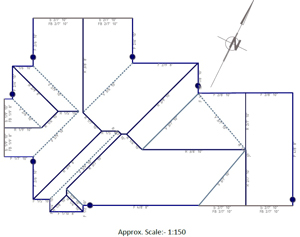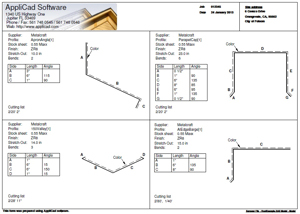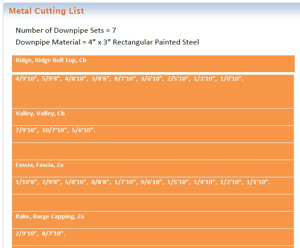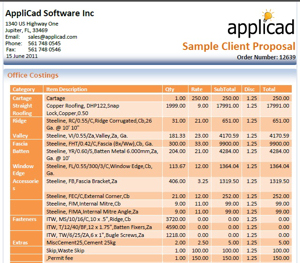Metal Roof Trim: There Is A Better Way
By Ray Smith, AppliCad USA Inc.
I have had the good fortune of exhibiting at the International Roofing Expo for 19 of the past 20 years, which gives me a point of comparison between this year’s event and those in the past. Reflecting on the 2013 show, what I find really interesting is the shift that has occurred in the products being exhibited. Since I am in the software business with products specifically developed for the roofing, cladding and solar industries, I make it my business to notice these things. Indeed I must if I am to survive the heart-pounding march of technological development that we see in every aspect of our daily lives.
 |
The roof plan showing placement of each of the cut lengths. Almost totally eliminates errors and unnecessary waste. | |
 |
The workshop detail drawing created by the software for both cut to length and stock length trim pieces ensures that the correct item is selected. | |
 |
Layout and wall trim placement. |
 |
A detailed list of the exact trim lengths required after having fabrication and installation allowances automatically applied. | |
 |
A summary of costs for each item of inventory, including clips, brackets, screws, etc. | |
Compared to just a few years ago, the floor space dedicated to “hi-tech” products at this latest show was quite amazing. AppliCad was there of course, but so were many other companies that sell software and hardware solutions for the roofing contractor, each purporting to deliver the solution to every roofer’s problem. If we include the number of computer controlled machines that are used to manufacture roofing products, especially metal roofing, plus a few more squares for solar energy products, then nearly half the exhibit floor space was set aside for some very high technology products – at a roofing convention!
One of the questions I was asked by an attendee at this year’s show was, “What could we be doing better in the metal roofing business?” May I suggest that we should open our minds to what opportunity this is really presenting for the industry and how to better engage with some of the technology.
We have people using our software in over 125 countries and this provides me the opportunity to chat with a huge number of people doing all sorts of things in the roofing industry. Some are worth mentioning and many are curious at best. Based on my experiences and insights, the first thing one must do is ask a simple question: “What exactly is the problem I am trying to solve here?” Trade show attendees must understand what they want to do. And only then will they know the questions they should be asking technology vendors at trade shows. Sometimes the most effective improvement to a business is not the one that costs the most!
I have observed in the North American market, trim is often seen as something you do after you get the roof cover installed, something to waterproof the edges. It is indeed very important for that very reason, and often very expensive; indeed a significant proportion of the total cost to waterproof a roof. In all of the 70+ trade shows I have done around the world, not a single roofer has ever come up to me and asked, “Can you estimate my trim more effectively?” as the first question. This indicates to me that they do not see this as the most important problem they want solved. I ask myself “Why not?”
I have done literally thousands of demonstrations of our software to roofers and manufacturers all over the world and before I do anything, I always ask, “what are you doing now and what problem do you want fixed?” The typical answer is along the lines of “win more jobs’, “do better estimates”, “improve the presentation”, “be more accurate”, “reduce waste” etc. These are all useful things to do and we ultimately do our best to oblige and demonstrate how we can assist. But let’s look at something that will improve the bottom line almost as much as any other single process in a roofing business and relatively easy to implement – and it doesn’t require a satellite image or a computer file in ‘the Cloud’.
In North America there are thousands of miles of trim fabricated in folders or press brakes every day. The machines are high-tech and have some of the best computer graphics on the front-end controllers you have ever seen. Folding trim is the way it has been done for a long time. But I think there is a better way.
The problem I see with folders/brakes is that the incremental cost of the output is huge – compared that is, to the cost of continuous roll-forming the same profile. Using a roll-formed section, we could pump out trim at cents per foot rather than dollars per foot.
Part of the problem here is that everyone thinks they have the better “mousetrap” and they want so many ‘custom’ profiles to suit the trim system that someone designed many years ago before roll forming profiles was even a possibility. If we could agree on a range of standard profiles that address the majority of roofing situations the production problems would be reduced, inventories are reduced, lead times are reduced. I reckon some clever mechanical engineers could come up with trim systems that used maybe 10 or 12 standard profiles for most situations (and many manufacturers do this already). Provide a range of standard sections and combinations that everyone uses for the same situation.
Metal roofing systems might then become more cost competitive. We already know that it is the best roof system for the longer term, but the costs to install are too high, the cost of product being too high, etc.
Yes, you need to improve the way you develop your quotation to install this stuff, and you can using our software – because embracing roll formed trim, you’re estimating ‘cut-to-length’ (instead of - “grab a few 10ft sticks of ridge cap, Fred!”) and this does indeed require accurate material cutting lists that have accounted for manufacturing and installation variables such as join laps.
The key to the success of inexpensive (relatively) ‘cut-to-length’ trim, is to have a system that generates the cutting list for this trim as accurately as possible, as fast and as easily as possible. That is where AppliCad’s Roof Wizard can help - by producing a very accurate cutting list with a complete breakdown of all accessory items including corners, brackets, clips, screws, sealant etc. and then produce order forms for your suppliers and the workshop – the lot, and entirely automatically.
Instead of ordering your trim in multiples of 10 feet, order it cut-to-length using a standard profile that is cost-effective and with limited or no joints at all. It looks fabulous on the finished job.
How will that improve the bottom line of your business? Simplify design solutions, reduce the cost of staff training (for installation) and give the customer a perfectly good result. Worth considering?
About AppliCad
 AppliCad USA Inc. is a specialty CAD applications software development company focused on the needs of the roofing, cladding and solar industries. To learn more,visit www.applicad-usa.com.
AppliCad USA Inc. is a specialty CAD applications software development company focused on the needs of the roofing, cladding and solar industries. To learn more,visit www.applicad-usa.com.